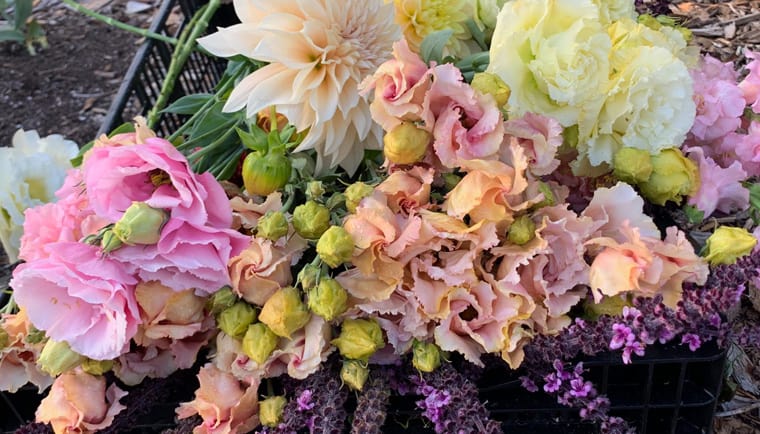

How to Grow Lisianthus
A rose by any other name…
[sibwp_form id=]
By My Thanh Kim, Skagit County WSU Extension Master Gardener
Call it love at first sight. Four years ago, I fell hard for some mysterious flowers in a lobby of a hotel. They looked like roses except more striking with an abundance of green buds surrounding luxurious blooms. This was the beginning of an obsession. I checked nurseries for plants but had no luck. Over the next several years I saw them again, and then, while watching the 2020 (2021) Tokyo Summer Olympics, I saw my beauties, lisianthus flowers prominently displayed and my love affair with them started all over again.
While hard to find in flower nurseries it is possible to start lisianthus from seeds. Mastering the seed-starting techniques was a months-long process, but well worth it. In the end, I had nearly 2,000 plants and gave away buckets of beautiful blooms all summer long. These are the best flowers ever, and I want everyone to enjoy them.
Lisianthus, Eustoma grandiflorum, (commonly called prairie gentian, bluebell gentian) are valued for many reasons including their resemblance to roses, their long vase life as cut flowers, and their unique beauty. They come in many vibrant colors, romantic soft tones, and mysterious bicolor flowers. In addition to their colors and shape, they are sought after by florists for their strong stems, lush succulent leaves, and graceful buds that continue to open in a vase for several weeks. They are hardy in USDA hardiness zones 8-10. Lisianthus is not hard to grow, and starting them from seeds may be your best option if you want to have these gorgeous flowers blooming in your garden this summer.

Rosanne Green Lisianthus
Photo by My Thanh Kim

Lisianthus stems can be 18-36″ tall
Photo by My Thanh Kim

Lisianthus blooming in the author’s garden. Photo by My Thanh Kim
January is the perfect time to start lisianthus seeds
It’s January. It’s dark and cold. Though it is too early to start many seeds indoors but it is not too early to start lisianthus. Since they need at least 6 months from planting to bloom, starting them early is a must. Growing lisianthus from seeds is not for the faint of heart. They need constant attention for several weeks if not months. You may need to try multiple times before you can master the skill. Follow these tips and with some practice and patience, you’ll be able to get many beautiful plants for your garden.

My Thanh Kim, Skagit County Master Gardener
Get started with seeds, a container, seed starting mix
Make sure you get seeds from a reputable source. Lisianthus seeds can be challenging to germinate so make sure the seeds are fresh. The germination rate goes down with older seeds. You want to start with the best seeds possible. Seeds from reputable companies should come in pelleted form for easy handling. Seeds can also be collected from mature flowers. They must be handled with care because they are tiny like specs of dust.
Choose a container or tray that is at least 1.5″ deep to allow room for root growth unless you are starting them in soil blocks. Soil blocking is a method of starting seeds that allows for healthy root growth. Sterilize the container before planting the seeds to prevent diseases.
Don’t start in garden soil. Instead, choose a sterile seed starting mix that has either coco coir or peat moss. Since lisianthus seeds are so tiny, you’ll need a medium that is as fine as possible to allow for better contact with the seeds, sifting out all the large pieces before using it.

Lisianthus seed pods contain tiny seeds.
Photo by My Thanh Kim

Lisianthus seedlings. Photo by My Thanh Kim

ABC purple, Voyage 2 green, ABC green, and Rosanne green lisianthus. Photo by My Thanh Kim
Light, temperature, and moisture are critical to seed germination
Lisianthus seeds are considered some of the most difficult to germinate but provided with the right conditions, you’ll have a better chance of success. One of the most important things to remember is that lisianthus seeds need light to germinate. Sow the seeds on the surface of the seed starting mix and do not cover them. Keep the seeds from drying out by misting them with a spray bottle several times a day. Cover the tray with a clear plastic cover until they germinate in 10-14 days. The seeds germinate best at a temperature of 70 degrees Fahrenheit.
Congratulate yourself when the seeds germinate
If the seeds have germinated, pat yourself on the back. You’ve done the hard part. When about 50% of the seeds have germinated, remove the plastic cover. Place the seedlings under grow lights and fertilize lightly every week. Seedlings can be planted in the garden when they have 4 sets of true leaves. Lisianthus can tolerate some frost so they can be planted outside 6 weeks before the date of your last frost. Plant them in a sunny location in well-drained soil and water when the soil is dry. If everything goes well you will have beautiful blooms in July or August.
Quick Summary Tips
Getting lisianthus seeds to germinate is not hard but requires commitment and patience. Here is a summary of the tips to help get the seeds to germinate.
- Fill a tray or container with some fine and sterile seed starting mix.
- Sow the seeds on the surface of the mix. They need light to germinate so do not cover them with the mix.
- Spray a few times a day to prevent the mix from drying out but do not over-water.
- Cover the tray with a clear plastic cover to retain moisture.
- Place under light to germinate. A desk lamp, LED light, or fluorescent shop light will work.
- Keep the tray at room temperature around 70 degrees Fahrenheit.
- Remove the plastic cover once about 50% of the seeds germinated (10-14 days).
- Feed lightly every week. Place under grow lights.
- Plant out in the garden or container once they have 4 sets of true leaves.
- It may take multiple attempts to be successful but keep practicing. They are worth it.
About the Author:
My Thanh Kim is a graduate of the Skagit County WSU Extension Master Gardener Class of 2022. She currently serves as the greenhouse co-manager for the SCMG. She has a BS in biochemistry from Tulane University and a teaching credential for San Diego State University.
Resources
Zigler, Lisa Mason (2014) Cool flowers: How to grow and enjoy long-blooming hardy annual flowers using cool weather techniques. St. Lynn’s Press, Pittsburg, PA.
Questions about home gardening or becoming a master gardener, may be directed to: WSU Skagit County Extension Office, 11768 Westar Lane, Suite A, Burlington, WA 98233; by phone: 360-428-4270; or via the website: www.skagit.wsu.edu/mg
Washington State University Extension helps people develop leadership skills and use research-based knowledge to improve economic status and quality of life. Cooperating agencies: Washington State University, U.S. Department of Agriculture, and Skagit County. Extension programs and policies are available to all without discrimination. To request disability accommodations contact us at least ten days in advance.